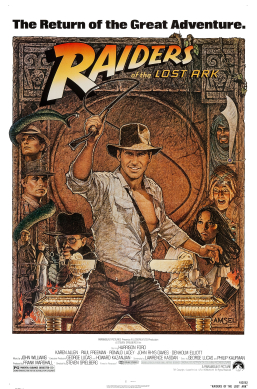Related Research Articles

The Abyss is a 1989 American science fiction film written and directed by James Cameron and starring Ed Harris, Mary Elizabeth Mastrantonio, and Michael Biehn. When an American submarine sinks in the Caribbean, a US search and recovery team works with an oil platform crew, racing against Soviet vessels to recover the boat. Deep in the ocean, they encounter something unexpected.

Raiders of the Lost Ark is a 1981 American action-adventure film directed by Steven Spielberg from a screenplay by Lawrence Kasdan, based on a story by George Lucas and Philip Kaufman. Set in 1936, the film stars Harrison Ford as Indiana Jones, a globetrotting archaeologist vying with Nazi German forces to recover the long-lost Ark of the Covenant which is said to make an army invincible. Teaming up with his tough former romantic interest Marion Ravenwood, Jones races to stop rival archaeologist René Belloq from guiding the Nazis to the Ark and its power.

Benjamin Burtt Jr. is an American sound designer, film director, film editor, screenwriter, and voice actor. As a sound designer, his credits include the Star Wars and Indiana Jones film series, Invasion of the Body Snatchers (1978), E.T. the Extra-Terrestrial (1982), WALL-E (2008), and Star Trek (2009).

John Barry was a British film production designer, known for his work on Star Wars, for which he received the Academy Award for Best Art Direction.
Brian Johnson is a British designer and director of film and television special effects.

Dennis Muren, A.S.C is an American film visual effects artist and supervisor. He has worked on the films of George Lucas, Steven Spielberg, and James Cameron, among others, and has won nine Oscars in total: eight for Best Visual Effects and a Technical Achievement Academy Award. The Visual Effects Society has called him "a perpetual student, teacher, innovator, and mentor."
Ronald Ray Cobb was an American–Australian artist. In addition to his work as an editorial cartoonist, he contributed concept art to major films including Dark Star (1974), Star Wars (1977), Alien (1979), Raiders of the Lost Ark (1981), Conan the Barbarian (1982), Back to the Future (1985), The Abyss (1989), Total Recall (1990), and Southland Tales (2006). He had one credit as director, for the 1992 film Garbo.

Richard Alan Baker, known professionally as Rick Baker, is an American retired special make-up effects creator and actor. He is mostly known for his creature designs and effects. Baker has won the Academy Award for Best Makeup a record seven times from a record eleven nominations, beginning when he won the inaugural award for the 1981 horror comedy film An American Werewolf in London.

Roger John Christian is an English set decorator, production designer and feature film director. He won an Academy Award for his work on the original Star Wars and was Oscar-nominated for his work on Alien. Christian directed the second unit on both Return of the Jedi and Star Wars: Episode I – The Phantom Menace as well as feature films including The Sender and Nostradamus. He also directed the 2000 film Battlefield Earth.

Michael Dickins Ford was an English film art director and set decorator.

Norman Reynolds was a British production designer and art director, best known for his work on the original Star Wars trilogy and Raiders of the Lost Ark.

Daren R. Dochterman is an American illustrator and set-designer. He illustrated for Get Smart, Rush Hour 3, Monster House, Poseidon, Sky High, and Master and Commander: The Far Side of the World. He is otherwise credited with The Chronicles of Riddick, The Terminal, Dr. Seuss' How the Grinch Stole Christmas, The Flintstones in Viva Rock Vegas, The Nutty Professor, Sleepless in Seattle, and James Cameron's The Abyss. Dochterman has twice been a guest of honor at the science, science fiction, and fantasy convention, CONvergence.Dochterman was recognized for his work by having shared a Video Premier Award for his supervision of visual effects in the movie Star Trek: The Motion Picture. He was also a conceptual illustrator on the film G.I. Joe: The Rise of Cobra.
Harry Hans-Kurt Lange was a German film production designer and art director.
Stephen B. Grimes was an English production designer and art director. He won an Oscar and was nominated for two more in the category Best Art Direction.
Bill Malley is an American production designer and art director. He was nominated for an Academy Award in the category Best Art Direction for the film The Exorcist.
Brian Savegar was a production designer in the film and TV industry. He won an Academy Award in 1986 in the category Best Art Direction for the film A Room with a View.
Harold William Varney was an American motion picture sound mixer. A two-time Academy Award winner, Varney shared the Academy Award for Best Sound Mixing for Star Wars: Episode V - The Empire Strikes Back in 1980 and Raiders of the Lost Ark in 1981. Varney also received Academy Award for Best Sound Mixing nominations for his collaborative sound mixing on Dune in 1984 and Back to the Future in 1985.

John Bruno is an American visual effects artist and filmmaker known for his prolific collaborations with director James Cameron on films like Terminator 2: Judgment Day, True Lies, Titanic, Avatar, and The Abyss, for which he won the Academy Award for Best Visual Effects.
The 42nd Saturn Awards, presented by the Academy of Science Fiction, Fantasy and Horror Films and honoring the best in science fiction, fantasy, horror, and other genres in film, television, home entertainment, and local theatre in 2015 and early 2016, were held on June 22, 2016, in Burbank, California, and hosted by actor John Barrowman. Nominations were announced on February 24, 2016. This ceremony featured several major changes on the television side, with all "Best Television Series" categories being replaced by new ones, with the exception of Best Superhero Adaptation Television Series.
Nigel Phelps is an English production designer, set designer and conceptual illustrator. Phelps is best known creating the drawings of Gotham City as art director on Tim Burton's Batman (1989), for which the film's art department was honoured with an Academy Award. Phelps is also a three time MTV Video Music Award for Best Art Direction nominee.
References
- 1 2 Jankiewicz, Pat (November 2019). "The Man Who Built R2-D2: Leslie Dilley". The Best of Star Wars Insider. Vol. 11: Aliens, Creatures and Droids. London: Titan. p. 23. ISBN 9781785851964 . Retrieved 8 March 2020.
- ↑ Waddell, Calum (October 2015). "The Art of War". Star Wars Insider. No. 140. p. 50. Retrieved 8 March 2020.
- ↑ Langman, Larry (2000). Destination Hollywood: The Influence of Europeans on American Filmmaking. Jefferson, North Carolina and London: McFarland & Company. p. 186. ISBN 078640681X . Retrieved 8 March 2020.
- ↑ Waddell 2015, pp. 50, 52
- 1 2 "Leslie Dilley". British Film Institute. Archived from the original on 6 May 2016. Retrieved 8 March 2020.
- 1 2 "Leslie Dilley". Contemporary Theatre, Film and Television. Vol. 44. Gale. 2002 – via Gale in Context.
- ↑ dePriest, Joe (25 July 1988). "Art director keeps the ocean on his mind". Rocky Mount Telegram. p. 11.
- ↑ "Academy Award nominations told". Kilgore News-Herald. 14 February 1990. p. 3.
- ↑ "The 62nd Academy Awards (1990) Nominees and Winners". oscars.org. Retrieved 1 August 2011.